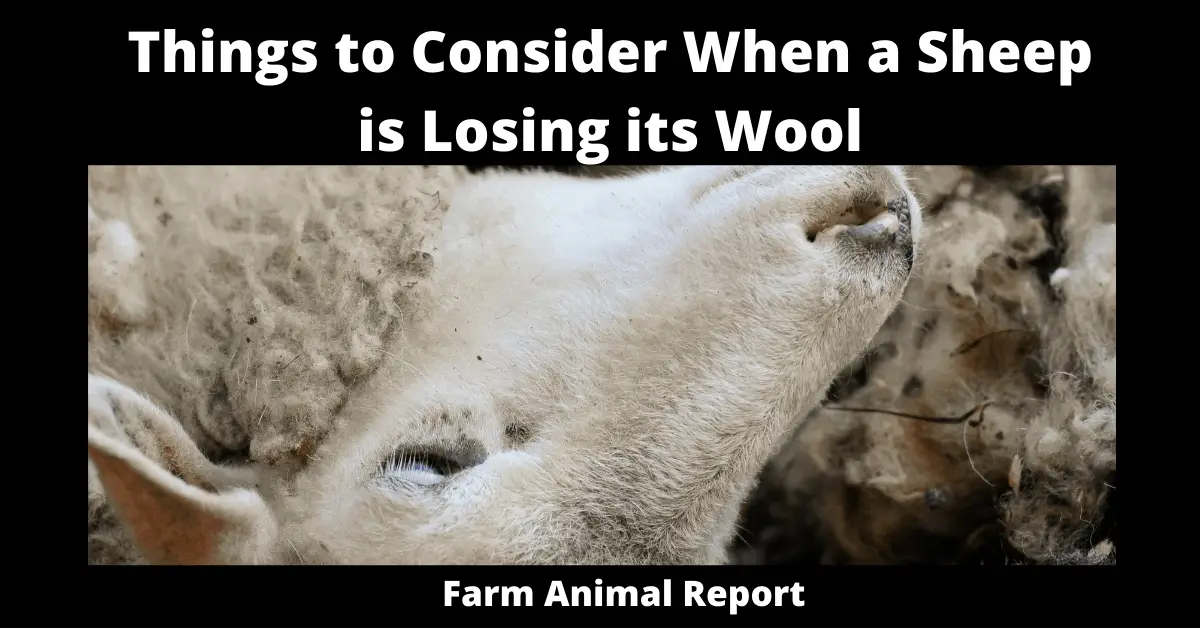As a General Rule Sheep can prematurely lose their wool. 1) Wool Slip 2) Wool Break 3) Natural Shedding 4) Parasites Stress in the form of malnutrition, reproduction, or disease will result in the thinning of the fiber and even reduction in the production of wool thus leading to hair loss
Why Sheep is Losing its Wool
Why My Sheep is Losing its Wool? Sheep is one of few domestic animals usually bred for the purpose of wool and can potentially produce meat and milk along with. These have been being reared for a long. The wool on the sheep is usually trimmed once a year.
Check Out Amazon Educational Resources for Raising Sheep
The wool produced is used for different purposes either utilized in the local industry in making of different goods like carpets or clothing. It can also be exported to get profit. Sometimes the sheep may lose their wool due to different reasons but this is mainly of cosmetic and psychological concern. The wool loss in sheep may be frequent as hair loss in humans. If the wool loss is frequent then this problem must be brought to light.
Sheep is Losing its Wool / Probable Causes of Hair Loss in Sheep
Wool loss in sheep is considered usually a negative sign. The health of the sheep is usually reflected by the quality of its fiber. Stress in the form of malnutrition, reproduction, or disease will result in the thinning of the fiber and even reduction in the production of wool thus leading to hair loss. The presence of fleece present on the surface of the sheep can increase its maintenance cost because heat loss is compensated by increased feed intake in colder climates. Hair loss in sheep may be due to one of the following reasons based on the study conducted on wool loss in sheep
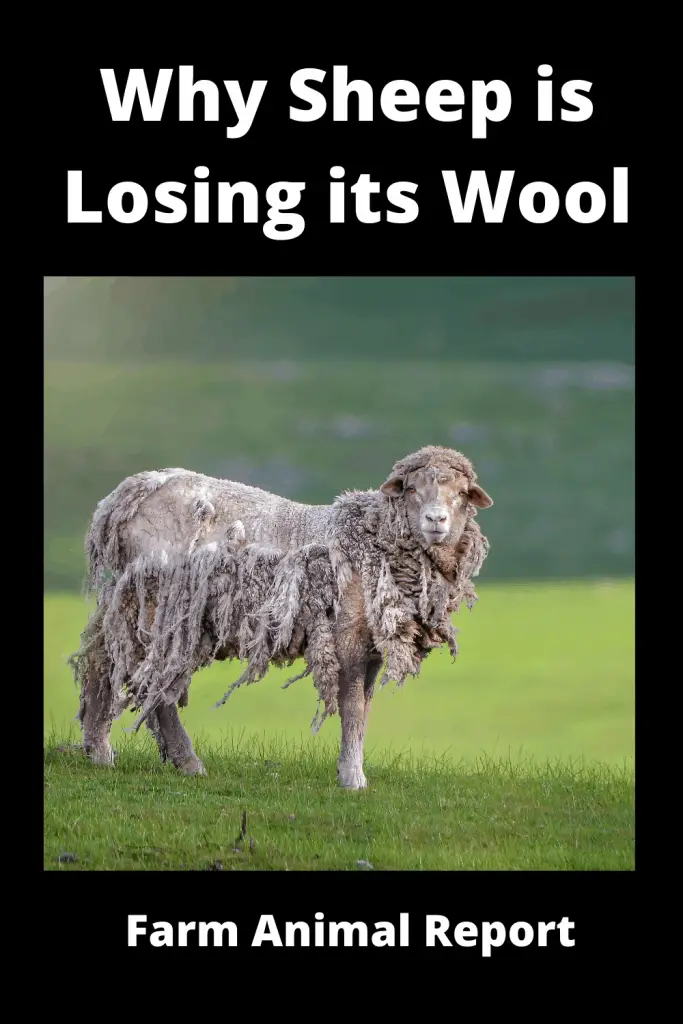
- The wool and fiber natural shedding
- Mechanical causes
- Differential diagnosis
- Ovine telogen effluvium – wool slip
- Bacterial dermatitis
- Pledora dermatitis
- Wool break
- External parasites
- Scrapie
- Feed related causes
- Genetic cause
- Alopecia
The Wool and Fiber Natural Shedding
The wool fibers are developed from hair follicles that are formed in three stages during the development of the fetus. The central primary follicles are considered the first follicles to develop and then spread in the skin of the fetus at almost 70 days.
At 85 days fetus, lateral primary follicles develop on the lateral side of primary follicles, in groups of three, together with secondary follicles. On day 105 the secondary derived follicles develop in between the earlier formed and branch out of primary follicles.
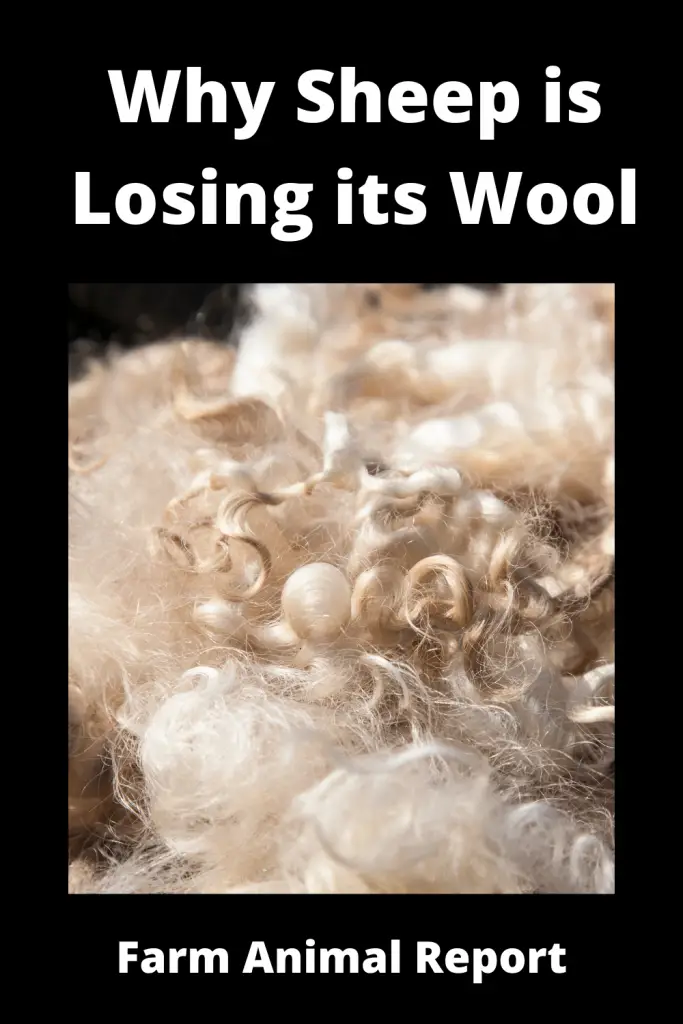
One month after almost all the follicles are producing wool fibers. The primary follicle fibers are usually larger in size than that secondary follicle fibers. During the life cycle of sheep, each follicle goes through some stages that lead to the natural shedding of hair. The reason for the shedding of the hair may include
- To control the length of hair
- To enable the animal to grow
- To clean the body by shedding old hair
- To suit different weather conditions
- To protect diseases that can spread through hair follicles
The cyclic activity differs in different breeds of sheep but each wool fiber goes through the same stages.
Phases of Wool Growth
Wool fiber grows in different phases that include the following
- Anagen phase
- Catagen phase
- Telogen phase
- Exogen phase
Anagen Phase
The anagen phase is the first phase in the growth of hair follicles in their cyclic growth. This is the phase when hair grows. The length of the anagen phase will determine the length of the hair follicle. During this phase, the cells of the hair follicle proliferate and differentiate so that the right type of shaft is produced at the right place of the body.
It has been found in some experiments that trauma can initiate the anagen phase, but it has also been found that the trauma must have to reach the threshold level to initiate the anagen phase. Anagen is prevented by glucocorticoids but will resume when the glucocorticoids are not present.
Catagen Phase
It is also considered a regressing phase. This phase is initiated when the follicle growth is completed. Pigmentation and cell growth cease, the papilla is released from the bulb, and the follicle shrinks due to apoptosis, a programmed cell death. The signal inducing is unknown but stress can trigger the catagen phase, along with trauma and different chemicals.
Telogen Phase
Telogenphaaase is the resting phase where the hair or wool is no longer growing but stays in place.
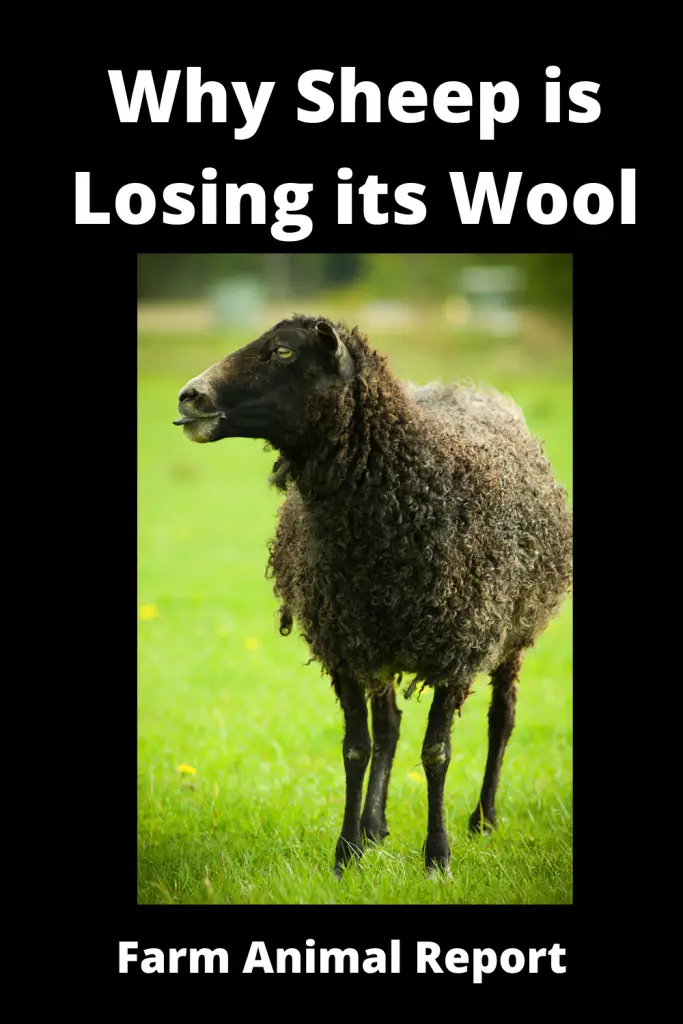
Exogen Phase
Exogen phase is the last phase where the wool or hair is shed..
Normally, new hair or wool will grow when the old hair or wool is shed. . And several shafts can be present at the same time. The anagen and the exogen phase do not have to be related events.
Differential Diagnosis
Wool loss is differentially diagnosed from alopecia. Alopecia is considered the complete absence of wool on sheep surface where it grows normally. Rather it means that the hair fails to grow and gives the appearance of a bold look. The hair in shedding usually gets thinner firstly then breaks easily upon applying pressure. Hair loss is usually categorized into two categories
- Generalized hair loss
- Localized hair loss
Generalized hair loss can be caused by drugs, stress, or severe illness while localized hair loss can be caused by alopecia aerota species, infections, or injuries.
Mechanical Causes
Before suspecting a disease cause, mechanical causes regarding hair loss must also be considered. Lambs playing or sleeping on the back of the sheep may cause wear and tear of the hair loss in sheep in the areas of contact of mother and lamb. The interior of the stable, the construction of the feeding areas could be the possible cause of hair loss in the sheep, especially around the neck while feeding or drinking from water sources.
Wool Slip
The technical term used for the wool slip is Ovine telogeneffluvin is detected by the moth-eaten look of the patches and the surrounding of the wool. The technical meaning of disease is ‘’ loss of telogen hair in the disease of follicle’’.
Skin biopsies taken from sheep affected with telogen effluvium showed that the wool follicles were in the anagen form as compared to the telogen phase in the unaffected animals. These findings support that the cyclic activity has been disrupted and the wool has been shed prematurely and that the wool follicles already are in the anagen phase again.
Bacterial Dermatitis
The bacterium ‘’dermatophiluscongenolensis’’ causes mycotic dermatitis or lumpy wool. It is more common in damp areas where rain or high humidity keeps the wool from drying. Breeds with fine down-type fleece are more prone to infection. If the bacteria invade the external skin then the result is exudative dermatitis, which dries and forms scabs at the base of fibers.
The infection increases the risk of flystrike commonly. After healing new wool will grow underneath the scabs that form a hard layer in the fleece. The back is most commonly affected but lesions can also appear in the ears and on the head. Wool loss is present in severe cases, where itching and secondary infections are more common.
During the lesion stage, the skin is pain-sensitive and this may restrict the movement of sheep.e the sheep is bound to live or stand at a single position. A form of this disease is called ‘Strawberry foot rot’ with strawberry-like nonexudative dermatitis and scabs localized above the hoof.
Peloderadermatitis
Pelodera dermatitis causes thickening of skin and wool loss in sheep. It is a rare infection caused by larvae of pledora ‘’strongyloides’’ a free-living saprophytic nematode. The larvae invade the hair follicles and cause an inflammatory response. They thrive in humid, decaying organic matter, such as dirty beddings. This disease has been described in a flock of crossbred Rasa aragonea ewes. The symptoms were found in areas in contact with the bedding material when the ewes were lying down. The clinical examination showed large areas of thick and leathery exfoliating skin with lesions in 74% of the skin. After complete removal of bedding, cleaning, and disinfection of the stables the problems disappeared. It, exactly, is working in accordance with the benefits of cleanliness.
See Our Extensive Guide – 16 Ways to Make Money Sheep Farming
Wool Break
The wool break is when the wool fibers are thinned and eventually break, causing parts of wool fleece to loosen. This could be secondary effects caused by malnutrition or diseases such as mastitis. A wool break can also have infections cause such as Johne’s disease caused by mycobacterium avium. Ringworm, Trichophyton verrucosum, can cause wool loss if the animal is scratching the area because of an itch.
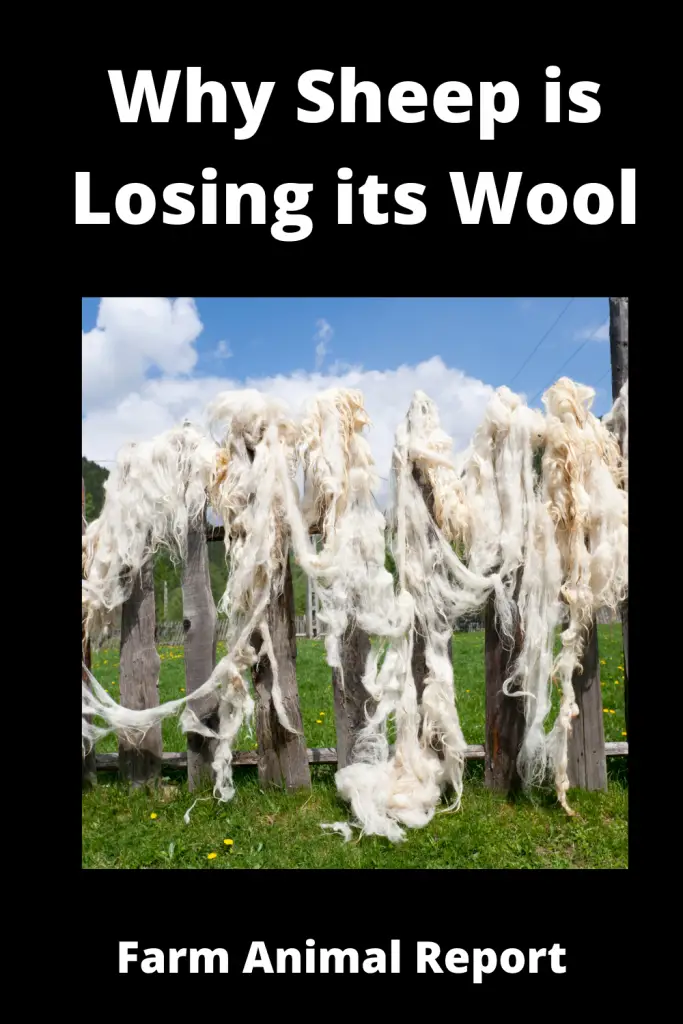
External Parasites
External parasites or ectoparasites are present on the outer surface of the body and maybe one of the probable causes of wool loss in sheep. It might include various things described below as
- sheep scab mite, psoroptesovis
- Chorioptesovis, foot scab
- Demodexovis, demodectic mite
- darmalinaovis, the biting louse
The sheep scab mite, psoroptesovis, causes symptoms such as restlessness and irritation. Scratching and biting the wool leads to wool loss and yellow pustules and crusts are seen at the edge of the lesion. In heavily infected sheep the mites can be seen with bare eyes around the lesions. The mites multiply rapidly and only a few mites that infect a sheep can in 8 to 12 weeks lead to severe infection. This mite is not found in colder areas.
Chorioptesovis, foot scab, can be found in colder areas and mainly affects the distal parts of the hind legs and the scrotum. It can cause wool loss and it is common to get secondary infections with allergic dermatitis in the areas after the treatment, making it difficult to evaluate if the treatment of the scab is effective or not.
Demodexovis, demodectic mite, is rarely found in sheep but can cause wool loss and itching when it infects the hair follicles and sebaceous follicles. This makes the wool oily and nodules may form in the skin. The eyelid is a common site for infection.
darmalinaovis, the biting louse. Is 1 to 2 millimeters long and visible for the naked eye? The symptoms of the infections are similar to that of the scab infection. The lice affect the wooly areas, mainly in the neck, back, and above the tail. They live in dandruff, hair, and skin secretions. The eggs are visible on the skin and the lice may survive up to 1 month without a host animal.
Scrapie
Scrapie is transmissible spongiform encephalitis. The symptom includes severe itching that leads to self-inflicted damages all over the body, wool loss, and a decline in overall health. Neurological signs are present in some cases for example changed behavior like fear, aggressiveness, fine tremor, over sensitivity for light, sound, and touch, and unsteadiness. Death occurs two to six weeks after infection. Scrapie is caused by the prions and the diagnosis is confirmed by autopsy. Scrapie is not found in Sweden at the moment.
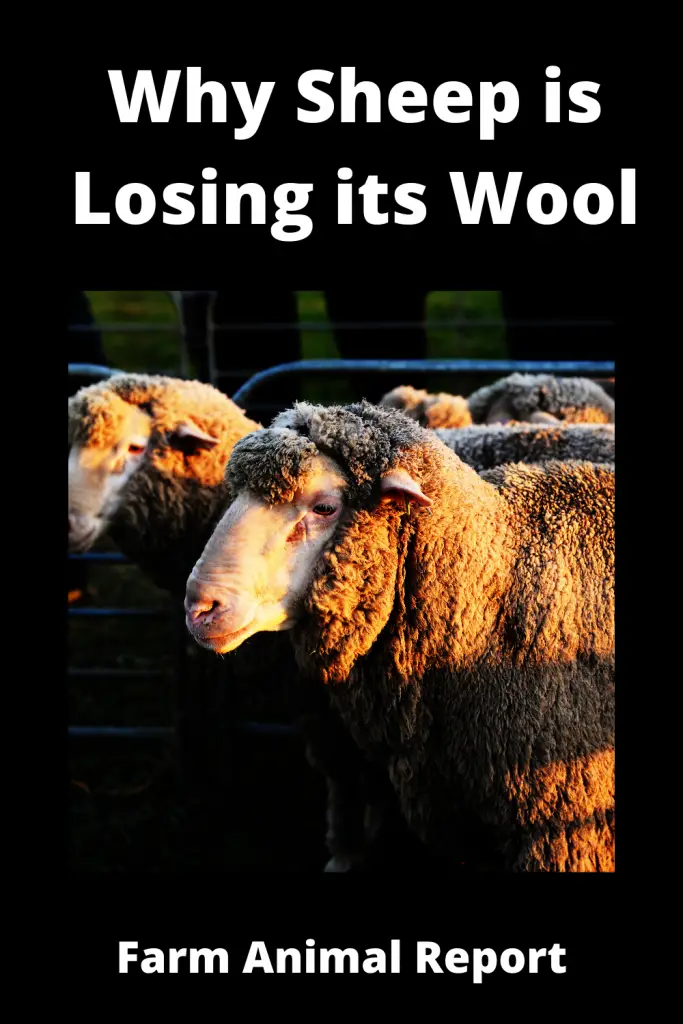
Feed Related Causes
Mineral deficiency and protein deficiency are stated as causes of wool loss in sheep. Deficiencies of copper, zinc, cobalt, calcium, phosphorous, sodium chloride, and manganese are all connected to wool plucking. Wool plucking or pulling is partner directed in sheep and the behavior is mostly performed by ewes. The most commonly affected area is the back.
Symptoms of zinc deficiency have been described as a loss of appetite, alopecia, lesions of the skin including parakeratosisand hyperkeratosis, and a decreased body weight. Alopecia is found in almost 62.4% of the sheep that were zinc deficient. Poor wool growth was also noted.
Excess of selenium can cause wool loss. The selenium excess causes mild wool loss on the neck and sides in sheep. No adverse effects are visible on the reproductive system of sheep.
During an investigation for the effect of protein on wool production, it was found that wool production continued during malnutrition. Wool production is more related to energy intake than protein intake.
Genetic Causes
Some breeds are more disposed to suffer from alopecia than others due to a hereditary increase in metabolism. Fat-tailed sheep shoes are strong shedding in spring, but wool loss appears earlier in winter and spring when the feed availability is the scarcest. No strong evidence of wool loss was found in link with genetics, other than natural shedding.
Sheep Farming for Wool Profitability Table
| Sheep | Lambs / 3 Per Yr | Space Required 20 Sq Feet - Each | Grazing Acres .3 / Sheep | Feed Required / Yr $100 | 15 Lbs Wool / Year | Average Price $ 10 / LB Wool | Total Revenue Possible |
|---|---|---|---|---|---|---|---|
| 1 | 3 | 60 sq ft | .9 acres | $ 300 | 45 lbs | $ 450 | $ 150 |
| 2 | 6 | 120 sq ft | 1.80 acres | $ 600 | 90 lbs | $ 900 | $ 300 |
| 5 | 15 | 300 sq ft | 4.5 acres | $ 1,500 | 225 lbs | $ 2,250 | $ 750 |
| 10 | 30 | 600 sq ft | 9 acres | $ 3,000 | 450 lbs | $ 4,500 | $ 1,500 |
| 20 | 60 | 1200 sq ft | 18 acres | $ 6,000 | 900 lbs | $ 9,000 | $ 3,000 |
| 30 | 90 | 2,700 sq ft | 27 acres | $ 9,000 | 1,350 lbs | $ 13,500 | $ 4,500 |
| 40 | 120 | 4800 sq ft | 36 acres | $ 12,000 | 1,800 lbs | $ 18,000 | $ 6,000 |
| 50 | 150 | 3,000 sq ft | 45 acres | $ 15,000 | 2,250 lbs | $ 22,500 | $ 7,500 |
| 100 | 300 | 6,000 sq ft | 90 acres | $ 30,000 | 4,500 lbs | $ 45,000 | $ 15,000 |
| 200 | 600 | 12,000 sq ft | 180 acres | $ 60,000 | 9,000 lbs | $ 90,000 | $ 30,000 |
Sheep can Produce 2 - 30 lbs of wool per year depending on Breed
Raw washed Wool Runs $ 6 - $ 14 using average $ 10
Feed 5 Months Buying Hay $ 100 rest Grazing
Please Check my Numbers
Sheep Farming for Milk Profitability Table
| Sheep | Lambs / 3 Per Yr | Space Required 20 Sq Feet - Each | Grazing Acres .3 / Sheep | Feed Required / Yr $100 | Wool $ 15 lb / Year | Average Price $ 10 / LB Wool | 90 Gallon/ Yr each ewe | Price $ 30 per Gallon | Total Wool Revenue Possible | Total Revenue Milk and Wool |
|---|---|---|---|---|---|---|---|---|---|---|
| 1 | 3 | 60 sq ft | .9 acres | $ 300 | 45 lbs | $ 450 | 270 | 8100 | $ 150 | 8,250 |
| 2 | 6 | 120 sq ft | 1.80 acres | $ 600 | 90 lbs | $ 900 | 540 | 16,200 | $ 300 | 16,500 |
| 5 | 15 | 300 sq ft | 4.5 acres | $ 1,500 | 225 lbs | $ 2,250 | 1350 | 40,500 | $ 750 | 41,250 |
| 10 | 30 | 600 sq ft | 9 acres | $ 3,000 | 450 lbs | $ 4,500 | 2700 | 81,000 | $ 1,500 | 82,500 |
| 20 | 60 | 1200 sq ft | 18 acres | $ 6,000 | 900 lbs | $ 9,000 | 5400 | 162,000 | $ 3,000 | 165,000 |
| 30 | 90 | 2,700 sq ft | 27 acres | $ 9,000 | 1,350 lbs | $ 13,500 | 8100 | 243,000 | $ 4,500 | 247,500 |
| 40 | 120 | 4800 sq ft | 36 acres | $ 12,000 | 1,800 lbs | $ 18,000 | 10,800 | 324,000 | $ 6,000 | 330,000 |
| 50 | 150 | 3,000 sq ft | 45 acres | $ 15,000 | 2,250 lbs | $ 22,500 | 13,500 | 405,000 | $ 7,500 | 412,500 |
| 100 | 300 | 6,000 sq ft | 90 acres | $ 30,000 | 4,500 lbs | $ 45,000 | 27,000 | 810,000 | $ 15,000 | 825,000 |
| 200 | 600 | 12,000 sq ft | 180 acres | $ 60,000 | 9,000 lbs | $ 90,000 | 54,000 | 1,620,000 | $ 30,000 | 1,650,000 |
Sheep can Produce 1/2 Gallon Milk per day / 180 Day Lactation
Raw Sheep Milk $9 - $25 per Quart - Used $ 30 per Gallon for Table
Feed 5 Months Buying Hay $ 100 rest Grazing
Please Check my Numbers
| Wool Producing Countries | Percentage of Market 2017 |
|---|---|
| Australia | 6 % |
| China | 14 % |
| United States | 17 % |
| New Zealand | 2 % |
| UK | 3 % |
| Turkey | 3 % |
| Mongolia | 2 % |
| Argentina | 1 % |
| Urguay | 1 % |
18 Breeds of Hair Sheep FAQ Table
| Hair Breeds of Sheep | Country Origin | Purpose of Breed | Use | Ewe Weight |
|---|---|---|---|---|
| Katahdins | Caribbean / Maine / Africa | To Graze Power lines / instead of Chemicals | Meat | 120 - 160 lbs |
| Dorper | South Africa | Thrive in Africa / Hot Climate | Meat / Fast Growing | 230 LBs |
| Blackbelly | America | Hot Climates | Meat | 150 LBs |
| St. Croix | Carribean | Came on Ships for Meat for sailors | Meat | 150 lbs |
| Romanovs | Russia | Primarily for Meat | Meat Wool - Double Coated | 110 lbs |
| Blackhead Persian | Africa / Somaila | Bred for High Quanity of Fat | Meat | 120 lbs |
| West African Dwarf | South / Central Africa | Meat | 55 lbs | |
| Red Maasi | East Africa | Bred for Hardiness and parasite Resistance | Meat | 77 Lbs |
| Wiltshire Horn | England | Do not suffer from Flystrike | Meat | 149 lbs |
| Royal White | United States / Texas | Bred for Tender Meat and Disease Resistants | Meat | 175 lbs |
| California Red | Not completely Hair sheep/ Combination of both/ Prod 2 lambs Yr | Meat | 140 lbs | |
| Damara | Egypt | Vigorous with fast growing / in extreme conditions | Meat | 110 lbs |
| Pelibuey | Cuba / Mexico | Tropical Sheep | Meat | 75 lbs |
| Africana | Columbia / Venezula | Meat | 110 lbs | |
| Morada | Brazil | Survive Scrub | Meat | 66 lbs |
| Brazillian Somaila | South Africa / Somali | Meat | ||
| Uda | Africa | Long Legged Sheep | Meat | 88 lbs |
| Touabire | Africa | Dairy / Meat | 77 lbs |


